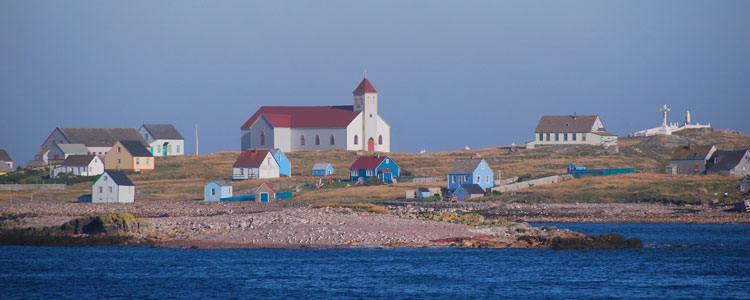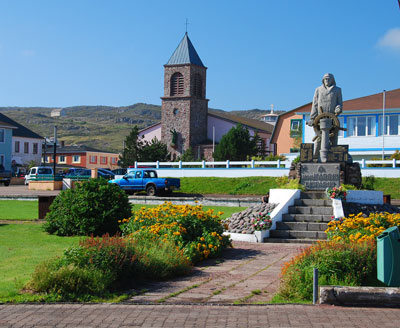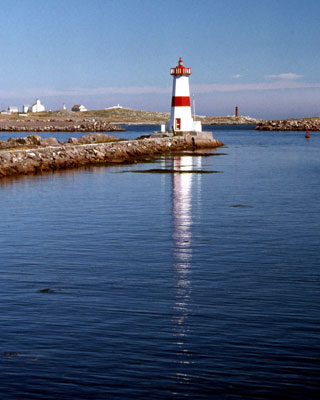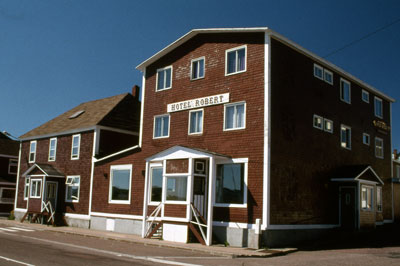St. Pierre and Miquelon – finding a touch of France in North America
by Ed Kinney, Roanoke, VA
Tucked less than 10 miles below Canada’s Newfoundland, where the Gulf of Saint Lawrence and the Atlantic Ocean meet, several very small French islands with a rich legacy await visitors.
The eight islands of Saint Pierre and Miquelon are mostly ignored by Americans. A few Canadians visit them, and some cruise boats plying the gulf stop there briefly, but those making the effort are rewarded with a touch of France in North America — the sound of church bells, the aroma of freshly baked baguettes, fishermen in slickers tending dories, boys playing pelote Basque (a version of jai alai) and French uniformed gendarmes.
The islands
These rocky islands, 150 square miles in size, are a self-governing overseas territory of France. People there live off the sea, similar to Newfoundlanders. About 6,000 people live on St. Pierre, 600 on the larger Miquelon-Langlade, with a third island, Île aux Marins, mostly abandoned, the ghostly remains of its few buildings left to tourists’ cameras. Perhaps 50 people or so live there during the summer.
My three-day visit to these islands brought back memories. My wife, Moreen, and I visited St. Pierre in 1997; this time, in September 2010, I traveled alone.
The weather remained capricious. On the Friday afternoon I arrived, one could see forever. On Saturday and Sunday, the weather toyed between drizzly and sunny. The sun fully returned on Monday, when I flew back to Halifax, Nova Scotia.
But I did note some changes. The islands have a new airport and a new Heritage Museum. The islanders, themselves, have changed as well, due to satellite communication. Locals are now worldlier.
Some history
The history of St. Pierre and Miquelon includes exploited people, the only guillotine execution in North America, a thriving prohibition business featuring Al Capone, and an invasion by Free French Forces during World War II. To learn about all of this, a visit to the island’s new Heritage Museum is a must.
Jacques Cartier landed in St. Pierre in the early 1500s, claiming the islands for the King of France. Turbulent times began during the War of the Spanish Succession, when St. Pierre was sacked nine times and burned twice. England’s 1759 victory over France in Québec further intensified life there.
St. Pierrias experienced starvation, invasion, capture and repatriation to France numerous times, yet they prevailed. The Second Treaty of Paris (1815) brought stability, restoring the islands to France.
Though small in size, these islands were and remain important, giving France fishing rights to the Grand Banks off Newfoundland.
Visiting St. Pierre
Although Canadian influence is increasing, mainly via TV, the pace in St. Pierre remains European. Two-hour lunch breaks are nearly compulsory; friends often kiss each other on the cheek when meeting, and locals readily lead travelers to desired destinations.
Automobiles aren’t needed, as most sites, hotels and restaurants are within easy walking distance of the harbor. Taxis cost about €5 ($7).
Goods in St. Pierre can be relatively expensive, as nearly everything must be imported.
I first stopped at the tourist office on Place du Général de Gaulle, across the street from the Newfoundland ferry dock in the center of St. Pierre. There they gave me maps, answered my typical tourist questions, provided recommendations for hotels and restaurants and sold me a ticket for the next day’s Zodiac adventure to Miquelon.
I would say that the best way to appreciate the charm of St. Pierre is to first take a tour of the island, then walk around on your own. Mrs. Maryvonne Fouchard (e-mail jcfouchard@cheznoo.net) met me upon my Air Saint-Pierre arrival. After seeing me settled into L’Hôtel Robert, she took me on a 1½-hour island tour. My airport pickup and tour were part of the package arranged for me by Maxxim Vacations (Newfoundland; 800/567-6666).
Highlights of my individual tour included the island’s cathedral, rebuilt in 1905-07; an outdoor pelote Basque fronton (court) where young boys were demonstrating their jai alai skills; World War I and II memorials, and the island’s beautiful aboveground burial sites. To me, the monuments in the cemetery rival those in Paris and Havana’s Cementerio Cristóbal Colón.
We also stopped numerous times, for photos of colorfully painted homes and views of Île aux Marins, including a stop at Pointe de View, overlooking St. Pierre, where Mary described the island’s isolation yet beauty.
Miquelon-Langlade
Though the weather looked slightly iffy on Saturday morning, several of us took the all-day tour to Miquelon-Langlade, two islands joined together by a sandbar. The tour, costing €63.50 (about $85), included one-hour Zodiac rides out to the islands and back in furnished foul-weather gear, Continental breakfast upon arrival on Langlade and a prepared sit-down midday meal, with wine, served in the restaurant/bar Chez Janot.
The tour used a 20-seat bus with a bilingual driver/guide.
As we jumped ashore from our Zodiac at L’Anse du Gouvernement on Langlade, the weather partially cleared. Langlade is uninhabited except during the summer months.
After breakfast and several cups of hot coffee, I wandered the beach area, admiring the well-kept summer homes that overlooked the harbor. High on a neighboring hillside stood Saint Therese Chapel.
Similar to buildings seen in St. Pierre, all were brightly painted in blue, orange, etc. The colors perhaps help the morale of islanders during long periods of inclement weather.
We toured Langlade by bus in the morning. Only 8½ by 5 miles wide, it is an untouched island. Here and there were a few randomly scattered homes.
Before the arrival of deported Acadians from Nova Scotia in the 18th century, large forests existed on Langlade. Now only scatterings of conifers remain.
Langlade’s cliffs overlook the Gulf of Saint Lawrence. Though not as striking as those in Nova Scotia’s Cape Breton, they do offer wonderful vistas of nearby Newfoundland, and the occasional whale may be seen.
After a very good, freshly prepared hot lunch at Chez Janot, we drove across the connecting seven-mile-long sandbar to Miquelon. There the landscape changed from scrub forests to peat moss and bogs and then to open, windswept, low, rolling hillsides.
At one place, when our tour operator and driver, Jean Clooney, stopped, several gentle horses, as if on cue, wandered down from the hillsides for a handout. Sheep and a few llamas were also seen as we drove toward the small village of Miquelon.
Most of the permanent 600 or so island inhabitants, living seemingly at the water’s edge, are exposed to storms from the west. For an hour we visited the village’s brightly painted blue church, small museum, craft shop and harbor.
As does St. Pierre, Miquelon depends upon the sea. Life must be harsh there. I assume many, especially the young, opt to stay in St. Pierre during the long winter months.
Our group returned to Langlade at 4 p.m. to reboard our Zodiac and return to St. Pierre, crossing the strait known by fishermen as the “mouth of hell,” due to its strong, weather-driven currents. For this reason, tours to Miquelon are occasionally canceled.
For me, the return with the sea spray in my face only enhanced my tour of Miquelon. I should note, however, that this Zodiac adventure would be extremely difficult for those with mobility problems. There are no docking facilities at Langlade, so reboarding a floating Zodiac from the sandy beach can be tricky.
The day’s excursion costs €60 per adult and is available from June through September. For more information, visit www.chezjanot.fr
One final day
On my last full day in St. Pierre I’d planned on taking the boat trip to Île aux Marins (Seamen’s Island), perhaps 10 minutes from St. Pierre, but all crossings were canceled due to high winds and, hence, rough seas.
Instead, I wandered the streets of St. Pierre with my camera, revisiting the highlights seen on Friday’s tour with Maryvonne Fouchard and inhaling the atmosphere.
Leaving St. Pierre brought back memories of my 1997 visit to these North American islands with their touch of France. The changes I’d noticed, being minor, didn’t negate those memories.
The details
The official language on St. Pierre and Miquelon is French, but English is widely understood. For US and Canadian citizens, passports are required though visas are not.
The euro is used on the islands, but Canadian and American dollars are often accepted. There is an ATM near the tourist office (four-number pin required).
As the weather is unpredictable, I’d recommend taking a windbreaker, a sweater and possibly a raincoat.
The St. Pierre Tourist Board (phone 05 08 41 02 00) publishes a guide noting available hotels and B&Bs and their rates.
After having used Maxxim Vacations in 2009, I was very disappointed in the accommodations arranged by them in my three-day package on this trip. The B&B Auberge Quatre-Temps (€64) was several steps below the B&Bs provided previously. For this reason, I immediately moved to L’Hotel Robert, where I paid €80 per night, including daily Continental breakfast, for my three-night stay.
Maxxim made no immediate adjustment in my tour price of $1,065, which included my round-trip airfare from Halifax, Nova Scotia, to Saint Pierre. I have subsequently been advised that I would be reimbursed for two of the three nights at Auberge Quatre-Temps that were included in my original tour price.
Many area restaurants serve wonderful French cuisine made from local products. Twice I had an excellent dinner at L’Atelier Gourmand (12 rue de 11 Novembre), located only a few steps from L’Hôtel Robert. Dinner cost about €22 ($30) sans wine and tip. Hotels will make necessary dinner reservations.




